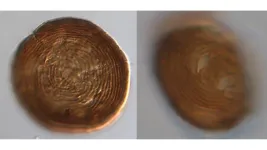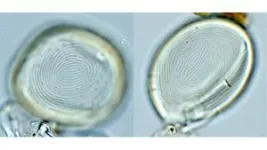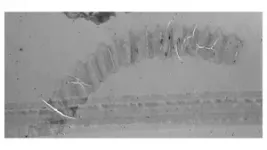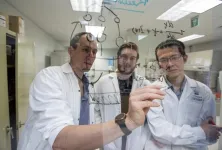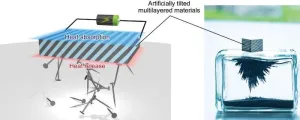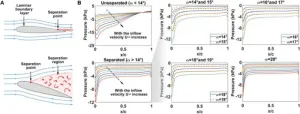(Press-News.org) Hiding in the shadows, euglenoids are a fascinating group of single-celled protists that are neither plant nor animal. Plants photosynthesize, and animals eat. Euglenoids do both. Spiraling along the murky bottoms of shallow fresh-water ponds with their long flagella, they eat organic goop, while also using their chloroplasts to convert CO2 and water with light into sugars. Because of this in-between status, euglenoids have been placed close to the very base of the eukaryotic branch on the tree-of-life that includes all plants, fungi, and animals. However, while euglenoids likely evolved more than 1 billion years ago, they appeared to have left only a very scant fossil record.
In a new study published in the journal Review of Palaeobotany and Palynology, a team of Dutch, American, British, German, and Australian scientists shed new light on a group of “problematic” microfossils that have remained a mystery for nearly a century. By comparing microscopic fossil cysts in 200-million-year-old pond sediments from cores drilled in Germany and the Netherlands to much older Paleozoic, and much younger remains in Holocene lakes in Greece, and finally to living protists in a pond in Australia, the researchers establish a 400-million-year evolutionary history of the euglenoids.
What’s in a name?
In 2012, Bas van de Schootbrugge, then at the Goethe University in Frankfurt am Main, and Paul Strother from Boston College, while working on a variety of problematic microfossils in sediments from around the Triassic-Jurassic boundary, realized that the circular striated cysts they were seeing, could be in fact euglenoid cysts. “We had this amazing drill core material at our disposal that contained many unidentified microfossils, including some of the oldest butterfly remains that we published on in 2018”, said Bas van de Schootbrugge, now at Utrecht University. Paul Strother continued: “Some of the microfossils we encountered showed a canny similarity to cysts of Euglena, a modern representative that had been described by Slovakian colleagues. The problem was, there was only one publication in the world making this claim”.
Even more unsettling: after an extensive literature review, van de Schootbrugge and Strother realized that the same type of microfossil had been given many different names. Scientists working on Quaternary and Holocene time slices used Concentricystes, referring to a possible algal cyst with concentric ribs. But Mesozoic workers used Pseudoschizaea, originally thinking it could have been a fern spore. Even older fossils from the Permian, Devonian, Silurian and Ordovician were known as Circulisporites and Chomotriletes.
Transmission electron microscopy
After the authors had disentangled the taxonomic confusion, compiling in the process nearly 500 literature sources related to any of the four taxa, more advanced microscope techniques were needed to establish the ultrastructure of the cysts with the help of transmission electron microscopy (TEM). This required picking of single specimens, embedding, and micro-tome slicing by University of Wisconsin-Eau-Claire co-author Wilson Taylor. Because the specimens in the Triassic-Jurassic cores were mostly damaged, the team turned to palynologist Andreas Koutsodendris at Heidelberg University (Germany), who had access to Holocene and Pliocene core samples containing abundant well-preserved specimens. Andreas Koutsodendris said: “I am encountering these cysts regularly in cores drilled in lakes, for example in Lake Vouliagmeni in Greece that we studied here, but their biological affinity has never been cleared. In fact, the cysts are commonly figured in publications by colleagues, but no one was able to really put a finger on it.” Wilson Taylor continued: “We were much surprised by the ultrastructure of the cysts. The structure of the wall does not resemble anything that is known. The ribs are not ornaments, like in pollen and spores, but part of the wall structure”, said Wilson Taylor. “The layered structure of the walls is also clearly different from many other fresh-water green algae”, Taylor continued.
Nagging uncertainty
While the TEM analysis initially added more mystery, the results did align with a study published in 2021 by another group of colleagues that looked at the ultrastructure of Pseudoschizaea. At least it was possible to show that Holocene and Pliocene Concentricystes and Jurassic Pseudoschizaea are in fact the same. But there remained one nagging uncertainty and that was the lack of any cysts produced by living euglenoids. Wilson Taylor: “We did contact several biologists working on living euglenoids, but no one had been able to make euglenoids encyst in a lab setting, allowing for extraction and TEM analyses of the cysts”.
Microscopic life down under
Enter Fabian Weston. By chance, Strother and van de Schootbrugge stumbled across superb video material posted on YouTube by microscopy enthusiast Fabian Weston from Sydney, Australia. In 2020 Fabian Weston had put a drop of water sampled from a nearby pond in New South Wales on a microscope slide, and using his advanced set-up at The Protist Lab filmed Euglena as it gracefully moved in and out of focus. For reasons that remain poorly understood but could be related to the drying out of the water under the cover slip, Euglena is then seen to ball-up and form a thick wall with ribs that is akin to the cysts found throughout the fossil record. “Unwittingly, Fabian provided a key piece of evidence. He is probably the only person on the planet to have witnessed Euglena encyst under a microscope”, Strother said.
Significance and next steps
Based on all the available pieces of the puzzle, the authors thus link euglenoids from a pond in Australia to fossil cysts that are more than 400 million years old, establishing a deep time record of the euglenoids. “This opens the door for recognizing even older examples, for example from Precambrian records that go back to the very root of the eukaryotic tree of life”, Strother said. “Now that we know which organisms produced those cysts, we can also use them for paleo-environmental interpretations. Their abundance around two of the largest mass-extinction events of the past 600 million years is a tell-tale sign of some major upheavals on the continents related to increased precipitation under extreme greenhouse climate conditions.” Van de Schootbrugge concluded: “Perhaps related to their capabilities to encyst, these organisms have endured and survived every major extinction on the planet. Unlike the behemoths that were done in by volcanoes and asteroids, these tiny creatures have weathered it all.” Extending their research, the team intends to travel to Australia in the near future to scour for preserved Euglena cysts in pond and lake sediments in New South Wales.
END
Microfossils shed light on the long fossil record of euglenoids
A 400-million-year evolutionary history
2024-01-16
ELSE PRESS RELEASES FROM THIS DATE:
Amnesia caused by head injury reversed in early mouse study
2024-01-16
WASHINGTON - A mouse study designed to shed light on memory loss in people who experience repeated head impacts, such as athletes, suggests the condition could potentially be reversed. The research in mice finds that amnesia and poor memory following head injury is due to inadequate reactivation of neurons involved in forming memories.
The study, conducted by researchers at Georgetown University Medical Center in collaboration with Trinity College Dublin, Ireland, is reported January 16, 2024, in the Journal of Neuroscience.
Importantly for diagnostic and treatment purposes, the researchers found that the memory loss attributed to head injury was not a permanent pathological event driven by ...
Domesticating plants impacts their microbiome, study finds
2024-01-16
New research led by the University of Oxford indicates that human domestication of crops can alter the communities of microorganisms that are associated with plants. Intriguingly, independent domestication events were found to have similar impacts on the plant microbiome. The results have been published today in Current Biology.
Lead researcher Dr Riccardo Soldan (Department of Biology, University of Oxford) said: 'Our study provides evidence that regardless of where and how domestication took place, domesticated ...
Reductive carboxylation of glutamine as a potential target in AML
2024-01-16
“Identification and validation of novel and targetable metabolic weaknesses in AML is ongoing.”
BUFFALO, NY- January 16, 2024 – A new editorial paper was published in Oncotarget's Volume 14 on December 1, 2023, entitled, “Reductive carboxylation of glutamine as a potential target in acute myeloid leukemia.”
In this new editorial, researchers Alessia Roma, Lawrence D. Goodridge and Paul A. Spagnuolo from the University of Guelph discuss acute myeloid leukemia (AML) — an aggressive cancer of the blood and bone marrow ...
Identity concealment in sexual minority men may have impeded mpox care
2024-01-16
ITHACA, N.Y. – Openly gay, bisexual and other sexual minority men were more likely than those who conceal their sexual orientation to seek care for mpox during a global outbreak of the disease last year that disproportionately affected their community, researchers from Cornell University and the University of Toronto found.
It wasn’t necessarily concern over being “outed” that kept some sexual minority men from seeking care for the disease, formerly known as monkeypox. According to the researchers, it was an information gap, partially attributable to separation from community due to identity concealment.
“The resource knowledge and community-connected ...
BSC predicts that global-mean temperature could reach the 1.5ºC warming level threshold in 2024
2024-01-16
2023 has just been confirmed as the hottest year on record, with global average temperatures exceeding pre-industrial conditions by 1.48°C, as stated by the Copernicus Programme of the European Union. Climate scientists from the Barcelona Supercomputing Center-Centro Nacional de Computación (BSC-CNS), based on the BSC decadal forecast system, were capable of predicting a year ago that 2023 had a high probability of being the warmest year on record.
After the record-smashing conditions in 2023, the imminent question is how the year 2024 and the following years will ...
New study aims to unlock secrets of the human brain
2024-01-16
The inner workings of the human brain are a gradually unraveling mystery and Dr. Richard Naud of the University of Ottawa’s Faculty of Medicine has led a highly compelling new study that brings us closer to answering these big questions. The study’s results have important implications for theories of learning and working memory and could potentially help lead to future developments in artificial intelligence (AI) since AI developers and programmers watch the work of Dr. Naud and other leading neuroscientists.
Published in Nature Computational Science, the study tackles the many-layered mystery ...
Pudukotai Dinakarrao studying ways to protect autonomous vehicle supply chains
2024-01-16
Sai Manoj Pudukotai Dinakarrao, Assistant Professor, Electrical and Computer Engineering, received funding for the project: "Cyber Sentinel: Safeguarding Autonomous Vehicle Supply Chains against Backdoors in Hardware."
Pudukotai Dinakarrao is working with University of Virginia researchers who aim to deploy a backdoor attack mitigation and avoidance approach for vehicles.
Haiying Shen, Associate Professor, Computer Science; Associate Professor, Electrical and ...
Thermoelectric permanent magnet opens new possibilities in thermal management technologies
2024-01-16
1. A NIMS research team has demonstrated that the transverse thermoelectric conversion (i.e., energy conversion between charge and heat currents that flow orthogonally to each other) can be greatly enhanced by applying magnetic fields or utilizing magnetism. In addition, the team developed a thermoelectric permanent magnet—a new functional material capable of thermoelectric cooling and power generation—by combining permanent magnets and thermoelectric materials into a hybrid structure. These results may guide in achieving thermal ...
Quantum computing and machine learning are effective tools in fluid dynamics
2024-01-16
To prevent aircraft stalls, engineers have long studied the flow of air over airfoils such as airplane wings to detect the angles when flow separation occurs. Recently, a team of researchers at Shanghai Jiao Tong University including Xi-Jun Yuan and Zi-Qiao Chen investigated the use of quantum computing in connection with machine learning as a more accurate way of solving such problems. Their research was published Nov. 21 in Intelligent Computing, a Science Partner Journal.
The use of a quantum support vector machine rather than a classical support vector machine increased the accuracy of classification of flow separation from 81.8% ...
Modified soft material promises better bioelectronics
2024-01-16
The scientific community has long been enamored of the potential for soft bioelectronic devices, but has faced hurdles in identifying materials that are biocompatible and have all of the necessary characteristics to operate effectively. Researchers have now taken a step in the right direction, modifying an existing biocompatible material so that it conducts electricity efficiently in wet environments and can send and receive ionic signals from biological media.
“We’re talking about ...
LAST 30 PRESS RELEASES:
Scientists trace microplastics in fertilizer from fields to the beach
The Lancet Obstetrics, Gynecology, & Women’s Health: Taking paracetamol during pregnancy does not increase risk of autism, ADHD or intellectual disabilities, confirms new gold-standard evidence review
Taking paracetamol during pregnancy does not increase risk of autism, ADHD or intellectual disabilities
Harm reduction vending machines in New York State expand access to overdose treatment and drug test strips, UB studies confirm
University of Phoenix releases white paper on Credit for Prior Learning as a catalyst for internal mobility and retention
Canada losing track of salmon health as climate and industrial threats mount
Molecular sieve-confined Pt-FeOx catalysts achieve highly efficient reversible hydrogen cycle of methylcyclohexane-toluene
Investment in farm productivity tools key to reducing greenhouse gas
New review highlights electrochemical pathways to recover uranium from wastewater and seawater
Hidden pollutants in shale gas development raise environmental concerns, new review finds
Discarded cigarette butts transformed into high performance energy storage materials
Researchers highlight role of alternative RNA splicing in schizophrenia
NTU Singapore scientists find new way to disarm antibiotic-resistant bacteria and restore healing in chronic wounds
Research suggests nationwide racial bias in media reporting on gun violence
Revealing the cell’s nanocourier at work
Health impacts of nursing home staffing
Public views about opioid overdose and people with opioid use disorder
Age-related changes in sperm DNA may play a role in autism risk
Ambitious model fails to explain near-death experiences, experts say
Multifaceted effects of inward foreign direct investment on new venture creation
Exploring mutations that spontaneously switch on a key brain cell receptor
Two-step genome editing enables the creation of full-length humanized mouse models
Pusan National University researchers develop light-activated tissue adhesive patch for rapid, watertight neurosurgical sealing
Study finds so-called super agers tend to have at least two key genetic advantages
Brain stimulation device cleared for ADHD in the US is overall safe but ineffective
Scientists discover natural ‘brake’ that could stop harmful inflammation
Tougher solid electrolyte advances long-sought lithium metal batteries
Experts provide policy roadmap to reduce dementia risk
New 3D imaging system could address limitations of MRI, CT and ultrasound
First-in-human drug trial lowers high blood fats
[Press-News.org] Microfossils shed light on the long fossil record of euglenoidsA 400-million-year evolutionary history
